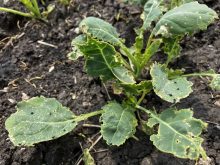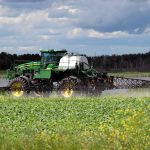Weekly Provincial Summary
- Harvesting of the earliest-seeded spring wheat and barley fields has started and preliminary yields are average to above average. Swathing of canola and oat crops continue across Manitoba, as does the winter wheat harvest.
- Aster yellows is evident in many canola and flax fields, with a range of severity. Higher-than-normal levels of root rot are also evident in spring wheat fields.
- Symptoms of heat and moisture stress continue to be evident in many crop types. In many areas of Manitoba, precipitation would be welcome to aid in grain filling, regrowth on pastures and hayfields, and continued growth in crops such as grain corn, sunflowers, edible beans and soybeans.
Read Also

CUSMA access key among other trade noise: Seeds Canada panel
Seeds Canada conference panelists say Canada needs to stay focused and wait as U.S. trade and tariff chaos develops, and a Canada-U.S.-Mexico Agreement review looms
Southwest Region
There was little to no rainfall. Warm, dry conditions are rapidly advancing crop development.
Winter wheat and fall rye harvest began late in the week. Most of the winter wheat acres have been desiccated and producers are swathing fall rye. Average winter wheat yields are reported with good quality and low protein.
Producers will start desiccating acres at week’s end. Dry conditions have caused premature ripening in saline areas of many fields, many of which are a result of the wet conditions in previous years. Fusarium head blight and root rot are prevalent in many wheat fields and are likely to impact yield and quality.
Heat has caused some canola flower abortion. Aster yellows is evident in majority of canola and flax fields.
The warm weather has helped the corn and sunflower crops but a rainfall would be welcome.
Producers who started grazing in early May are starting to see pastures deteriorate due to drier conditions.
Northwest Region
Later in the week saw widespread thundershowers, occasional high winds and variable precipitation amounts of 15 to 55 mm.
Wet soil moisture conditions through the northern areas of the region are improving; however, reduced crop condition, yellowing and ponding persists. Silage corn is beginning to tassel, with hemp and soybeans also responding well to the favourable heat and moisture. Winter wheat harvest has begun in the Ste. Rose and Dauphin areas. Perennial grass seed crops are being swathed.
Some economic levels of lygus bugs are reported on canola throughout the region. High alfalfa plant bug and lygus bug populations have affected pod set in some forage seed around Dauphin area. Aster yellows is occurring in almost all canola fields; some fields have 30 per cent of the stand impacted.
Hay yields are average or below and quality has declined further with weathering.
Central Region
Most areas have received little or no moisture during the last week.
Winter wheat harvest is completed in the Red River Valley and is well underway in the Somerset area. Yields in the Red River are reported to be between 60 to 100 bu./acre and the average yield being close to 80 bu./acre. Yields on barley are reported to be in the 80 to 100 bu./ac. range and early-spring wheat yields have been in the range of 50 to 70 bu./ac.
The hot, dry weather resulted in canola being swathed.
Soybeans are approaching the R4 growth stage where rainfall is critical for yield. Some cornfields are showing symptoms of heat and moisture stress.
Grasshoppers are showing up in fields. Lygus bug numbers are generally low, although isolated fields have numbers high enough to warrant control measures. Insect monitoring continues and many beneficial predators are present.
Hay crop is below average this year.
Livestock water supplies are tight and dugouts are below-average levels.
Eastern Region
Last week sunny and hot weather prevailed across the Eastern Region except for some severe rainstorms.
Most winter wheat crops were harvested. Reported yields range from 60 to 80 bu./acre. Bushel weights are in the 60-lb. range with very low fusarium head blight levels. About 40 per cent of canola is mature.
While the condition of annual crops in central and northern areas is generally rated as good, symptoms of moisture stress are noted in annual crops in the southern areas.
Spraying for lygus bug in canola continued where infestation levels deemed it necessary and crop was still in vulnerable growth stages.
In regards to haying operations, beef producers in southern areas are completing first cut. A growing number of hayfields will not be cut this year, or will not have a second cut done, due to the drier-than-normal conditions. Some pastures are impacted by the drier conditions; some producers have started feeding on pasture.
Interlake Region
The Interlake Region saw more hot and humid weather this week. Scattered thundershowers on Wednesday and Thursday morning, as well as on the weekend, left accumulations of up to 100 mm in localized showers.
Winter wheat harvest is complete in the south and well underway across the rest of the region. Rain and humidity have delayed harvest. Yields are reported in the 60 to 85 bu./acre range. Swathing of barley crops is general. Swathing of canola has started on crops across the region. There are reports of elevated lygus bug populations and some bertha army worm in canola with insecticides applied to a few fields.
Lygus bugs and black stem are affecting alfalfa seed fields with control measures being taken on many. Timothy seed harvest is underway.
First-cut haying continues for beef producers across the region while dairy producers have mostly completed the second cut.
Pasture conditions are good with recent rains allowing for good regrowth.


















